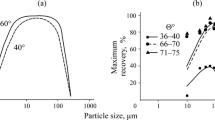Abstract
The computer experiments on air bubble attachment and detachment, with ore particles of 36 fractions with different size and copper content display the influence of air bubble diameter and energy dissipation on flotation selectivity. The concentration reached 80 at the optimized bubble diameter of 265 µm, which is 5–8 times higher than with the air bubble diameter of 1000–2000 µm standard for impeller flotation machines.
Similar content being viewed by others
References
Mitrofanov, S.I., Effect of Pulp Flow Rate on Flotation Rate and Selectivity, Tsvet. Met., 1941, no. 17.
Rubinstein, J.B. and Samygin, V.D., Effect of Particle and Bubble Size on Flotation Kinetics, Frothing in Flotation, 1998, vol. 2.
Schubert, H. and Bischofberger, C., On the Optimization of Hydrodynamics in Flotation Processes, Proc. 13th Int. Mineral Processing Congress, 1979, vol. 2.
Massinaei, M., Kolahdoozan, M., Noaparast, M., Oliazadeh, M., Yianatos, J., Shamsadini, R., and Yarahmadi, M., Hydrodynamic and Metallurgical Characterization of Industrial Columns in Rougher Circuit, Minerals Engineering, 2009, vol. 22.
Dobby, G.S. and Finch, J.A., Mixing Characteristics of Industrial Flotation Columns, Chemical Engineering Science, 1985, vol. 40(7).
Finch, J.A. and Dobby, G.S., Column Flotation, Oxford: Pergamon, 1990.
Changunda K. Deglon and Harris, M., Investigating the Effect of Energy Input on Flotation Kinetics in an Oscillating Grid Flotation Cell, Minerals Engineering, 2008, vol. 21.
Rulyov, N.N., Turbulent Microflotation of Ultrafine Minerals, Mineral Processing and Extractive Metallurgy, 2008, vol. 117, no. 1.
Massinaei, M., Mixing Characteristics of Industrial Columns in Rougher Circuit, Minerals Engineering, 2007, vol. 20.
Aslan, A. and Boz, H., Effect of Air Distribution Profile on Selectivity at Zinc Cleaner Circuit, Minerals Engineering, 2010, vol. 23, Nos. 11–13.
Samygin, V., Filippov, L., Matinin, A., Lekhatinov, Ch., and Tertyshnikov, M., New Multiple-Zone Flotation Cell—Device for Increasing Separation Selectivity, Proc. XV Balkan Mineral Processing Congress BMPC 2013, Sofia: Publishing House St. Ivan Rilski, ISBN 978-954-353-217-9, 2013, vol. 2.
Goryachev, B.Y., Nikolaev, T.G., and Ils’ina, B.Y., Analysis of Flotation Kinetics of Particles with the Controllable Hydrophobic Behavior, J. Min. Sci., 2010, vol. 46, no. 1, pp. 72–77.
Koh, P.T.L. and Schwarts, M.P., CFD Modelling of Bubble–Particle Attachments in Flotation Cells, Mineral Engineering, 2006, vol. 19.
Yoon, R.H. and Luttrell, G.H., The Effect of Bubble Size on Fine Particle Flotation, Mineral Processing and Extractive Metallurgy Review, 1989, vol. 5.
Dai, Z., Fornasiero, D., and Ralston, J., Particle–Bubble Attachment in Mineral Flotation, Journal Colloid and Interface Science, 1999, vol. 217, no. 1.
Schulze, H.J., Hydrodynamics of Bubble–Mineral Particle Collisions, Mineral Processing and Extractive Metallurgy Review, 1989, vol. 5.
Jameson, G.J., The Effect of Surface Liberation and Particle Size on Flotation Rate Constants, Minerals Engineering, 2012, vols. 36–38.
Kondrat’ev, S.A., Study of the Rupture of Gas Bubbles in Turbulent Liquid Streams, J. Min. Sci., 1987, vol. 23, no. 5, pp. 646–468.
Kondrat’ev, S.A. and Bochkarev, G.R., Stabilization of Bubble Size in a Flotation Cell, J. Min. Sci., 1998, vol. 34, no. 3, pp. 272–277.
Author information
Authors and Affiliations
Corresponding author
Additional information
Original Russian Text © V.D. Samygin, P.V. Grigor’ev, 2015, published in Fiziko-Tekhnicheskie Problemy Razrabotki Poleznykh Iskopaemykh, 2015, No. 1, pp. 145–152.
Rights and permissions
About this article
Cite this article
Samygin, V.D., Grigor’ev, P.V. Modeling hydrodynamic effect on flotation selectivity. Part I: Air bubble diameter and turbulent dissipation energy. J Min Sci 51, 157–163 (2015). https://doi.org/10.1134/S1062739115010214
Received:
Published:
Issue Date:
DOI: https://doi.org/10.1134/S1062739115010214




